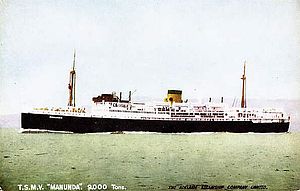- Manunda
-
Manunda was an Australian registered and crewed passenger ship which was converted to a hospital ship in 1940. During the war Manunda saw service in both the Middle East and Pacific Campaigns, specifically New Guinea. She resumed her passenger duties after the war, before being sold to a Japanese company and finally broken up in 1957.
Contents
Early history
In 1927 the Adelaide Steamship Company in Australia ordered a new 9,119 GRT liner to provide full-time Australian coastal passenger services, which had previously only been offered by the company on a limited scale.
The TSMV Manunda was built by William Beardmore and Company at Dalmuir in Scotland and was launched on 27 November 1928. Completed on 16 April 1929, she arrived in Australia in June 1929 to begin her duties on the Australian Coast Trade, running passengers and cargo between Sydney, Fremantle, Melbourne and Cairns.
She accommodated 176 First Class and 136 Second Class Passengers and sailed at a service speed of 15 knots. She was the largest ship operated by the Adelaide Steamship Company, and as a result of her success the company commissioned a larger, faster sister ship, the Manoora, which was completed in 1935.[1]
Manunda in World War II
The declaration of war saw Manunda fitted out as DEMS ship (Defensively Equipped Merchant Ship), under the control of the Australian Shipping Control Board.
She was converted to a Hospital Ship at Sydney in compliance with the Geneva Convention Regulations and was taken over by the authorities on 25 May 1940, and was commissioned as and as AHS Manunda 2/1 Hospital Ship on 22 July 1940, under Captain James Garden, previously Captain of the Adelaide Steamship Company Manoora and Commodore of the Adelaide Steamship Fleet. The General Hospital based on board was commanded by Lt. Col. John Beith, and members of the Australian Army Nursing Service (AANS) on board were led by Matron Clara Jane Shumack (1899-1974).
Manunda sailed on a “shake down cruise” to Darwin, Port Moresby and returned to Sydney, before heading for Suez in the Middle East (she made four trips to the Middle East and Mediterranean between November 1940 and September 1941). She was then despatched to Darwin.
On the morning of 19 February 1942, Manunda was damaged during the Japanese air raids on Darwin', despite her highly prominent red cross markings on a white background. 13 members of the ships’ crew and hospital staff were killed, 19 others were seriously wounded and another 40 or so received minor wounds. The Manunda was able to act as a casualty clearing station for injured personnel from other ships involved in the attack.
She sailed to Fremantle the next day.
Captain James Garden was later awarded the O.B.E, in 1945, for his bravery and skill, both during the attacks, in leading a fire extinguishing team on the ship and in later navigating it by the stars to Fremantle with no navigation equipment and a jury-rigged steering system.
After a refit in Adelaide, she went to Milne Bay in Papua New Guinea, where she acted as a floating hospital for the Allied forces who were stationed there. She spent several nights in Milne Bay, during attacks by Japanese warships, but her status as a hospital ship was, on this occasion unaccountably honored by Japanese naval units, which raked her with searchlights on three nights running.
She made a total of 27 voyages from Milne Bay to Brisbane and Sydney transporting wounded troops. As the war continued, she was relocated as required and she followed the Allied forces the various islands around the Pacific. Manunda's final wartime voyage was to New Zealand transporting civilian passengers. During the war she carried approximately 30,000 casualties to safety.
After the Japanese surrendered Manunda was despatched in September 1945 to Singapore to repatriate ex-POWs and civilian internees who had been imprisoned in Changi Prison. She also sailed to Labuan in Borneo to pick up ex-POWs and civilian internees from Batu Lintang camp.
Post war career
Manunda was decommissioned in September 1946 and received an extensive 18 month refit in Melbourne. She returned to service on 2 April, 1948, transporting passengers around the Australian coast. In September 1956 she was withdrawn from service and placed on the market. She sold very quickly and was purchased by Okadagumi Shipping Ltd of Japan. She sailed from Sydney for the last time as TSMV Hakone Maru on 4 October, 1956.
Sadly, the company’s plans for her did not eventuate, and she was broken up the next year in Japan, arriving in Osaka on 18 June 1957.
References
- ^ Short history of TSMV Manuda, ssMaritime.com
"Hospital Ships - Manunda, Wanganella, Centaur, Oranje" by Rupert Goodman
External links
- AHS Manunda, Australian Merchant Navy website
- 2/1 HMAHS Manunda, Peter Dunn's "Australia @ War" website
- history and photo of ward[dead link]
- HMAS Manunda History, far-eastern-heroes.org.uk
- Wartime wedding aboard Manunda, far-eastern-heroes.org.uk
- Manunda’s ship’s menu from Thursday 16 July 1953: Menu; Wine list, State Library of South Australia
- Silver dinner bell from MV Manunda, Australian War Memorial
- http://www.itsanhonour.gov.au/honours/honour_roll/search.cfm?aus_award_id=1109345&search_type=quick&showInd=true
Categories:- Maritime history of Australia
- Clyde-built ships
- Hospital ships of Australia
Wikimedia Foundation. 2010.


